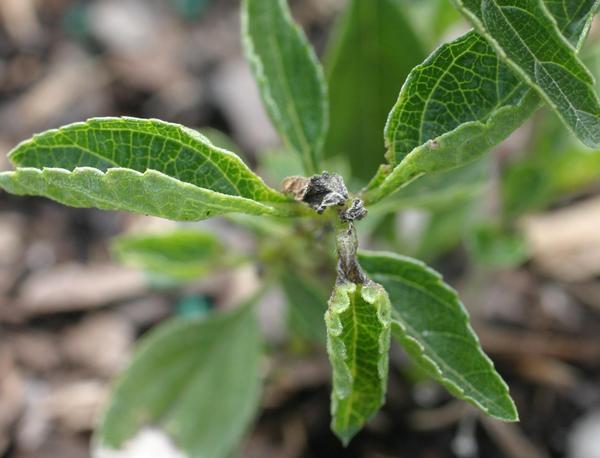Problem
Herbicide injury caused from cellulose-inhibiting herbicides such as indaziflam and isoxaben.
Symptoms
- Abnormal root and shoot tips.
- Mottled, puckered, chlorotic foliage and growing points.
- Roots may be swollen or have encircling necrotic bands just behind the root tips.
- Susceptable seedlings often do not emerge from the soil.
- Indaziflam may cause soil line girdling with occasional stem swelling just above the girdle on susceptible plants.
- Girdled stems often result in wilting followed by browning of entire above-ground portion.

Knockout rose tender young foliage is damaged by over the top spray application of indaziflam. Note the “puckered” foliage as well as tip necrosis. Photo two weeks after treatment.
J. Neal CC BY-NC-SA 4.0

Knockout rose foliage injured by over the top spray application of indaziflam. Photo two weeks after treatment.
J. Neal CC BY-NC-SA 4.0

Isoxaben injury to hydrangea. Tip necrosis forms within two weeks of over the top application.
J. Neal CC BY-NC-SA 4.0

Stem girdling by indaziflam over-dosing results in sudden death of above-ground tissues, usually in hot weather. Non-treated on left, treated on right.
J. Neal CC BY-NC-SA 4.0
Plant Entry and Symptom Expression
Cellulose inhibitors may affect both roots and shoots. Herbicides with this mode of action are usually applied prior to weed emergence but may cause injury to emerged and established plants by foliar absorption, inhibition of root growth, or stem girdling at or just above soil line. Roots and/or tender new shoots are injured within a few days following application. Soil movement is minimal and volatilization and photodegradation are not a concern.
Similar Problems
Cellulose and cell wall inhibitor injury may be confused with symptoms from:
- Stubby roots caused by dinitroanaline herbicides such as oryzalin, pendimethalin, prodiamine, trifluralin.
- The reduced root size and number caused by the mitotic inhibitor dithiopyr, a pthalic acid.
- Puckered, curled and mottled foliage may be confused with damage from dinitroanaline.
- Herbicides or sucking insects (such as aphids).
- Mottled foliage may sometimes be confused with nematode, plant virus and/or nutritional disorders.
Herbicide Mode of Action Category
Mode of Action Group 29
Useful Resources
North Carolina Agricultural Chemicals Manual
Southern Region Small Fruit Consortium
Southeastern US Vegetable Crop Handbook
Weed Management in Nurseries, Landscapes & Christmas Trees Information Portal
Applied Weed Science: Including the Ecology and Management of Invasive Plants (3rd Edition), Merrill Ross & Carol Lembi, pages 169, 181, 288-290
Publication date: Dec. 11, 2015
Reviewed/Revised: Aug. 3, 2023
N.C. Cooperative Extension prohibits discrimination and harassment regardless of age, color, disability, family and marital status, gender identity, national origin, political beliefs, race, religion, sex (including pregnancy), sexual orientation and veteran status.







